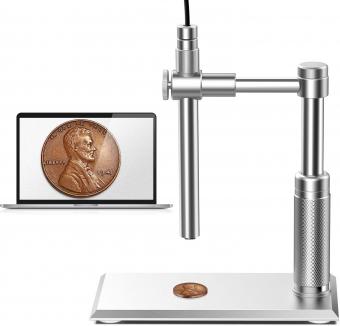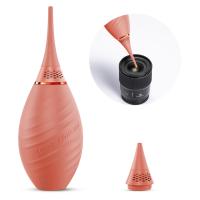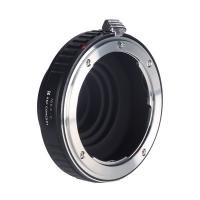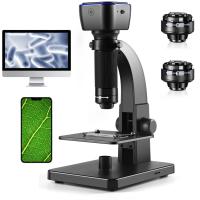Can You See Sperm With A Light Microscope ?
Yes, sperm can be seen with a light microscope. Sperm cells are typically around 50 micrometers in length and can be observed using a standard light microscope with a magnification of at least 400x. However, in order to see the details of the sperm cell, staining techniques may be necessary. One commonly used stain is the Papanicolaou stain, which highlights the various structures of the sperm cell. Additionally, phase contrast microscopy can be used to enhance the contrast of the sperm cells, making them easier to see. Overall, while a light microscope may not provide the highest level of detail, it is still a useful tool for observing sperm cells.
1、 Sperm morphology
Yes, sperm can be seen with a light microscope. However, the resolution of a light microscope is limited to about 200 nanometers, which means that only the general shape and movement of the sperm can be observed. To observe the fine details of sperm morphology, such as the shape of the head, midpiece, and tail, a higher magnification microscope, such as an electron microscope, is required.
Sperm morphology is an important aspect of male fertility, as abnormalities in sperm shape can affect their ability to fertilize an egg. The World Health Organization (WHO) has established strict criteria for normal sperm morphology, which includes the size and shape of the head, midpiece, and tail. Abnormalities in any of these structures can lead to reduced fertility or infertility.
Recent studies have also suggested that sperm morphology may be an indicator of overall health. For example, a study published in the journal Fertility and Sterility found that men with abnormal sperm morphology were more likely to have metabolic syndrome, a cluster of conditions that increase the risk of heart disease, stroke, and diabetes.
In conclusion, while a light microscope can be used to observe the general shape and movement of sperm, a higher magnification microscope is required to observe the fine details of sperm morphology. Sperm morphology is an important aspect of male fertility and may also be an indicator of overall health.

2、 Sperm motility
Can you see sperm with a light microscope? Yes, you can see sperm with a light microscope. Sperm cells are relatively large and can be easily observed under a light microscope. However, to see the details of the sperm structure, a higher magnification is required.
Sperm motility is another important aspect of sperm observation. Sperm motility refers to the ability of sperm cells to move and swim. This is an important factor in determining the fertility of a male. Sperm motility can be observed under a light microscope by placing a drop of semen on a slide and observing the movement of the sperm cells.
Recent advancements in microscopy techniques have allowed for the observation of sperm cells in greater detail. For example, confocal microscopy can be used to observe the three-dimensional structure of sperm cells. This technique uses a laser to scan the sample and create a detailed image of the sperm cell.
In conclusion, sperm cells can be observed under a light microscope, and their motility can be assessed. However, to observe the detailed structure of sperm cells, a higher magnification or advanced microscopy techniques may be required.

3、 Sperm count
Can you see sperm with a light microscope? Yes, you can see sperm with a light microscope. Sperm cells are relatively large and can be easily observed under a light microscope. However, to accurately count the number of sperm cells in a sample, a specialized microscope called a phase-contrast microscope is used. This type of microscope allows for better visualization of the sperm cells and can provide a more accurate count.
Sperm count is an important factor in male fertility. A low sperm count can make it difficult for a man to father a child. The World Health Organization (WHO) defines a normal sperm count as 15 million sperm per milliliter of semen. However, recent studies have shown a decline in sperm count in men from North America, Europe, Australia, and New Zealand. This decline has raised concerns about male fertility and the potential impact on future generations.
There are several factors that can affect sperm count, including age, lifestyle, and environmental factors. Men can take steps to improve their sperm count by maintaining a healthy lifestyle, avoiding exposure to toxins, and seeking medical treatment for any underlying health conditions.
In conclusion, while sperm can be seen with a light microscope, a phase-contrast microscope is needed for accurate sperm count. Sperm count is an important factor in male fertility and recent studies have shown a decline in sperm count in some parts of the world. Men can take steps to improve their sperm count and overall reproductive health.

4、 Sperm viability
Can you see sperm with a light microscope? Yes, you can see sperm with a light microscope. Sperm cells are relatively large and can be easily observed under a light microscope. However, the resolution of a light microscope is limited, and it may not be possible to see the fine details of the sperm cell structure.
Sperm viability, on the other hand, refers to the ability of sperm cells to fertilize an egg and produce a viable embryo. This cannot be determined by simply observing the sperm cells under a microscope. Instead, specialized tests are required to assess sperm viability, such as a sperm motility test or a sperm penetration assay.
Recent research has shown that the quality of sperm has been declining in recent years, with a decrease in sperm count, motility, and morphology. This has led to concerns about male fertility and the potential impact on human reproduction. As a result, there has been an increased focus on developing new techniques to assess sperm viability and improve male fertility.
In conclusion, while it is possible to see sperm cells with a light microscope, this does not provide information about sperm viability. Specialized tests are required to assess sperm viability, and there is ongoing research to develop new techniques to improve male fertility.






























There are no comments for this blog.